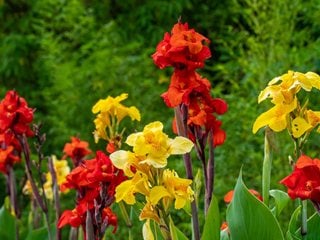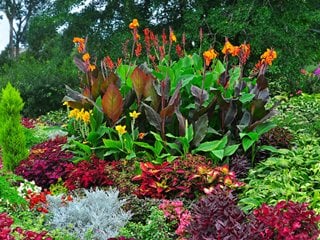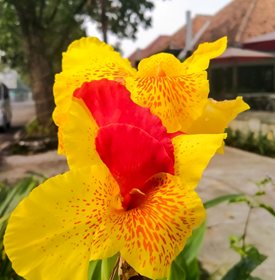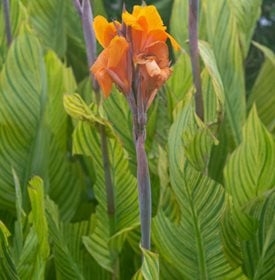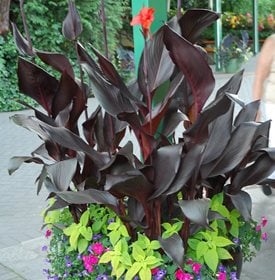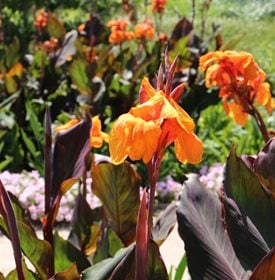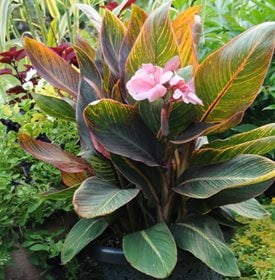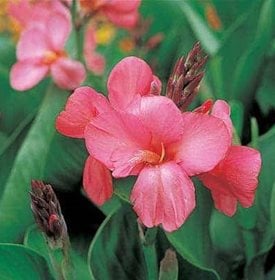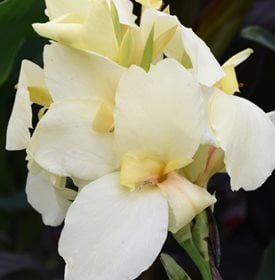How to Grow Colorful Cannas
Heat up your summer garden with these lush tropical blooms. Get planting tips, display ideas, and an introduction to some stunning varieties.Cannas may be the boldest of the summer bulbs, rivaling the striking floral beauty and impressive stature of the popular garden gladiolus. Even from a distance, cannas are show-stoppers and the perfect plants for turning your garden into a tropical paradise.
Although not a true lily (even though commonly called canna lily), the canna plant is every bit as showy. Cannas produce massive blooms in colors ranging from pale pastels to vibrant oranges and reds. The huge, jungle-like leaves are equally eye-catching and come in a broad array of solid and variegated colors.
Although cannas are herbaceous perennials in tropical climates, they can be grown as annuals almost anywhere as long as you give them ample sunlight and moisture. Cannas also come in a wide range of sizes, from container-friendly dwarf varieties to 6-foot-tall giants.
On this page: Basics | Planting | Care and Maintenance | Pictures | Overwintering | Design Ideas
On this page:
- BASICS
- PLANTING CANNA LILIES
- CANNA LILY CARE AND MAINTENANCE
- CANNA LILY VARIETIES
- OVERWINTERING CANNAS
- DESIGN IDEAS
THE BASICS
Botanical name:
Canna spp. and hybrids
Common names:
Canna, canna lily, Indian shot, arrowroot
Native area:
Tropical and subtropical regions of Central and South America
Plant type:
Although you will often see cannas labeled as “summer bulbs,” they actually grow from rhizomes.
Zones:
Perennial in zones 8-10; grown as annuals in Zones 2-7
Height:
From 18 inches to over 6 feet tall, depending on the variety
Exposure:
Partial shade to full sun
Bloom Time:
From early to midsummer until frost
Flowers:
Blooms in shades of yellow, red, pink, scarlet, orange, or creamy white occur in clusters at the top of tall stems. Some cultivars have striking bi- or multi-colored blooms. The flowers are short-lived, lasting only a day or two, but new ones soon follow to provide continual blooms all season.
Foliage:
Large and paddle-shaped, with prominent midribs and veins (similar in appearance to banana plant leaves). Can be various shades of green, dark purple, bronze or red, often with narrow stripes of color following the leaf veins.
Special attributes:
- Attracts hummingbirds and butterflies
- Deer resistant
- Extremely heat tolerant, thriving in hot and humid climates
- Fast growing
- Non-toxic and pet friendly
PLANTING CANNAS
When to plant:
In late spring or early summer, after all danger of frost is past and the soil has warmed up to at least 60 degrees F. A good general guideline is to plant cannas around the same time it’s safe in your area to put tomato plants in the garden.
Where to plant:
A position in full sun (6 to 8 hours daily) is best for good leaf color and flower development. However, cannas grown in the Deep South or the desert Southwest will benefit from some afternoon shade to keep the foliage from bleaching. If possible, plant your cannas in a spot sheltered from the wind to avoid damage to the large leaves.
How to plant:
Plant canna rhizomes in holes 3 to 4 inches deep with the eyes (or buds) facing upward. Space plants at least 2 feet apart to give them room to spread. Choose rhizomes that are firm and plump with at least three eyes. (More eyes often result in bigger, more robust plants.) Cover the rhizomes with 1 to 2 inches of soil and water thoroughly.
If you don’t want to wait for your cannas to grow from rhizomes, you can often find canna plants sold at nurseries, garden centers, and online in the spring. Plant at a depth no deeper than the top of the root ball, and follow the same spacing guidelines.
Planting cannas in containers:
If planting cannas in pots, choose a container large enough to allow the roots to spread and to prevent the plant from toppling as it grows to full height. Usually you’ll need a container at least 18 inches in diameter, unless you’re planting a dwarf canna variety. Self-watering containers are a good choice for cannas because of their demanding water requirements.
Soil:
Cannas thrive in rich soil high in organic matter, but will do fine in most garden soils as long as they receive consistent moisture.
HOW TO CARE FOR CANNAS
Watering:
Give these water-loving plants at least 1 to 2 inches of water per week during the growing season to keep the soil moist, particularly during dry spells. To help conserve soil moisture, apply a 2- to 4-inch layer of mulch around your plants.
Container-grown cannas will need more frequent watering to prevent the soil from drying out, as often as once or twice a day. Don’t worry too much about overwatering. In their native habitat, canna plants are often found growing close to or even partially submerged in water.
Fertilizing:
Cannas need a lot of nourishment to stimulate flower production and keep the foliage lush and attractive. In garden beds, work plenty of compost or other organic matter into the soil at planting time in the spring, along with a controlled-release fertilizer. Container-grown plants will also benefit from the application of controlled-release fertilizer, but may also need supplemental feedings with a water-soluble plant food starting in midsummer.
Deadheading:
It’s not necessary to deadhead cannas if you are growing a non-seeding variety, but if your plants begin to develop seedpods, pinching off the spent blooms will result in more prolific flower production. Be careful to remove only the fading flowers and not the buds still remaining on the flower spike. New blooms will continue to develop from that main stalk all summer.
Diseases and Pests:
Potential pest threats to cannas include slugs and garden snails, and Japanese beetles. However, the worst and most destructive pest is the canna leafroller, a caterpillar that feeds and pupates inside a rolled-up canna leaf before it opens, eating away the foliage from the inside out. Control measures include cutting off and disposing of the affected foliage or unrolling the leaves and removing the caterpillars by hand.
CANNA VARIETIES
Featured in: Garden Design's Top 10 Garden Trends for 2022 ("Including Plants that Transport You to the Tropics")
OVERWINTERING CANNAS
Unlike spring bulbs, cannas are sensitive to freezing temperatures and the rhizomes must be dug up in fall and stored until planting time the following spring. In mild climates where the soil doesn’t freeze, the rhizomes can be left in the ground over winter.
If you don’t want to part with your beautiful cannas when the growing season ends, here’s how you can preserve them for planting again the following spring:
- Leave your cannas in the ground until the foliage has died back. This allows the plant to store more food for next year's growth.
- When frost has blackened the foliage, cut the stalks off to several inches above the ground and carefully unearth the clumps of rhizomes.
- Let them dry for several days and then pack in peat moss, sand, or vermiculite and store in a cool, dark location that stays above freezing but below 55 degrees F.
- Look the rhizomes over occasionally throughout the winter and discard any that show signs of withering or disease.
- Before replanting in the garden in spring, divide the rhizomes, making sure each division has several eyes.
- Cannas planted in containers can be stored over winter by moving them inside in their pots to a cool, dark spot and allowing them to go dormant.
- If you live in a warmer climate (zone 7 or above) you can leave your cannas in the ground over winter, but it’s a good idea to protect them from temperature extremes by covering with a layer of mulch.
For more on planting and storing bulbs, see Bulbs 101.
CANNAS IN YOUR GARDEN
Cannas are not meant to be subtle. Their bold floral colors and flamboyant foliage create a big visual impact wherever you plant them. Here are ideas for taking advantage of their “look at me” qualities:
- Most cannas are tall and great for drawing the eye to the back of a garden bed, but you can also use dwarf varieties to add drama to the front of the border or as a central focal point in smaller garden beds.
- Grow cannas with other tropical flowers and plants such as lantana, papyrus, or coleus. Look for vibrant blooms and foliage that that are large and bright.
- Canna plants have the biggest impact when grown in groups of three or more. Planted in a row, they are also perfect for filling in narrow spaces, such as parkways.
- Cannas are fantastic thriller elements in mixed container plantings, especially when used with other boldly colored plants.
- Add a touch of the tropics to water gardens, ponds, and even boggy areas, where cannas will feel right at home. For these applications, it’s best to choose an aquatic canna variety that likes to be partially submerged in water, such as ‘Erebus’ or ‘Bengal Tiger’.
- Unfortunately, cannas aren’t good plants for the cutting garden, since the blooms won’t last in a vase. However, the gorgeous foliage is a stunning addition to both formal and informal floral arrangements.
RELATED:
More Bulbs for Your Garden
20 Best Summer Bulbs to Grow
20 Best Outdoor Foliage Plants
How to Grow Rose Mallow (Hardy Hibiscus)
